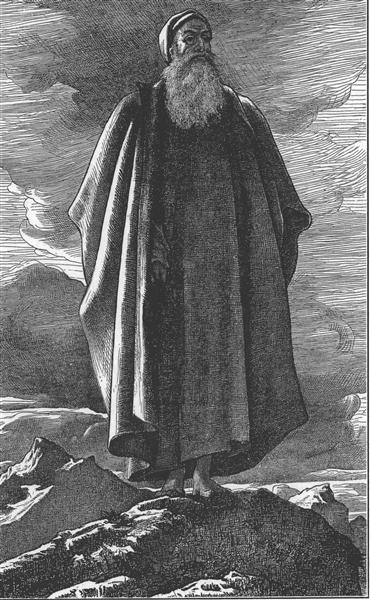Description
Frederic Leighton's Moses Sees the Promised Land is a masterful example of Victorian Neoclassicism, a style that encapsulates the elegance and emotion of a deeply resonant narrative. Created in 1895, this painting depicts a pivotal moment in the biblical story when Moses, the leader and prophet of the Hebrew people, looks down from the top of Mount Nebo upon the Promised Land, though he will never be able to enter it. Through this work, Leighton introduces the viewer to the duality of hope and sadness, a recurring theme in his work.
The composition of the painting is notable for its balanced structure, with Moses placed at the centre, making him the undisputed focus of the scene. The prophet is depicted in a contemplative posture, his face looking towards the horizon. The beauty of his figure, dressed in a flowing robe, reveals Leighton’s mastery in the representation of the human body and the importance of movement within painting. The figure of Moses is framed by a dramatic and expansive background that unfolds in a mountainous landscape, which reinforces the monumentality of his exploration and the sublime sense of his vision.
The use of color in Moses Sees the Promised Land is another of its most notable features. Leighton uses a rich, warm palette ranging from gold to deep blue, evoking an atmosphere of grandeur and spirituality. The warm tones in Moses' clothing contrast sharply with the cooler tones of the horizon, suggesting not only the depth of the landscape, but also an emotional connection between man and the divine. This relationship is heightened by the light that seems to emanate from the top of the work, illuminating the figure of Moses and highlighting his importance as a mediator between God and the people.
In terms of iconography, Moses Sees the Promised Land is set up as a symbol of struggle and perseverance. Moses is depicted as a lonely leader who, despite having led his people to freedom, faces the pain of not reaching the promised destiny. This deeply human message is reflected not only in Moses' expression, but also in the way Leighton has captured the essence of ambition and sacrifice.
The work falls within an artistic tradition that embraces symbolism and romantic ideals, where not only the visual aspect is valued, but also the emotional charge that the narrative can carry. Like other artists of his time, Leighton employs a meticulous technique that combines classical precision with a lively sensuality. As the viewer delves deeper into the work, the sense of time and history are intertwined in a continuous dialogue, where the figure of Moses becomes a vehicle for exploring the universal struggles of the human condition.
In conclusion, “Moses Sees the Promised Land” is much more than a mere visual representation; it is a profound meditation on the themes of hope, loss and transcendence. Frederic Leighton, through his technical skill and aesthetic vision, invites us to reflect on the universal and immutable truths that still resonate in our own experience. This painting is not only a legacy of Victorian art, but it also remains relevant in its ability to connect with the most intimate part of the human experience.
KUADROS ©, a famous painting on your wall.
Hand-made oil painting reproductions, with the quality of professional artists and the distinctive seal of KUADROS ©.
Painting reproduction service with satisfaction guarantee. If you are not completely satisfied with the replica of your painting, we will refund 100% of your money.

